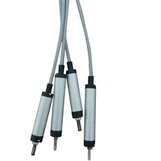Laser Linear Displacement Sensor
Laser displacement sensor is a high-precision measuring device based on optical principles. It is widely used in industrial automation and precision measurement fields, covering industrial automation, semiconductor manufacturing, automobile manufacturing, medical equipment, packaging and transportation industry, food and beverage industry, logistics and warehousing industry and consumer electronics and robotics industry. Laser displacement sensor has been widely used in many industries due to its high precision, non-contact measurement, high-speed response and other characteristics. Its core technologies include laser triangulation, optical imaging theory, Sham structure, filtering and noise reduction algorithm and machine learning model, etc., which ensure high-precision measurement capability in various complex environments. With the continuous advancement of technology, laser displacement sensor will play a more important role in intelligent manufacturing, precision measurement, robot vision and other fields.


● Micron-level resolution
Micron-level resolution enables stable detection even when the workpiece is small or the spacing is extremely narrow.
● Non-contact measurement
Avoids damage to precision devices caused by physical contact and improves measurement stability.
● High-speed detection
Can reach kHz-level sampling rate, adapt to high-speed assembly lines, and ensure real-time and accurate counting.
● Strong anti-interference ability
Not affected by ambient light, dust, and oil, ensuring stable detection in complex environments.
Basic Performance Parameters
|
Indicator name |
Index value |
|
Measuring range |
35mm~1200mm |
|
Repeatability |
20 μm |
|
Linearity |
0.10% |
|
Laser source |
650nm, 7mW, IIIA |
|
Spot size |
100μm~500 μm |
|
Response cycle |
1ms |
|
Supply voltage |
9V~30V |
|
Interface output |
Analog voltage/analog current/RS485 |
Dimension (mm) :

Application






competitive advantage
competitive price
We offer high-quality products at factory-direct prices, saving you cost without compromising quality.
long warranty
Our products come with an extended warranty, ensuring reliability and long-term satisfaction.The warranty is 12 months .
24H Online Service
Our support team is available 24/7 to assist with inquiries, orders, or after-sales service.
Global Shipping
We ship worldwide with fast and secure logistics, delivering to your doorstep efficiently.
Laser Displacement Sensors vs. Conventional Displacement Sensors
|
Laser Displacement Sensor |
Conventional Displacement Sensor |
|
|
Measurement Principle |
Based on laser triangulation or interferometry, calculating displacement by emitting a laser beam and analyzing reflected light. |
Potentiometer: Measures displacement via resistance changes. |
|
Measurement Method |
Non-contact: No physical touch, avoiding wear or interference. |
Contact (e.g., potentiometer, LVDT): Requires touching the object, risking wear. |
|
Accuracy & Resolution |
Accuracy up to micrometer (μm) or even nanometer (nm) level, with ultra-high resolution. |
Potentiometer/LVDT: Typically millimeter-level. |
|
Response Speed |
kHz-level sampling rate, ideal for high-speed dynamic measurements (e.g., vibration analysis). |
Potentiometer/LVDT: Slower (Hz-level). |
|
Application Scenarios |
- Precision manufacturing (semiconductors, electronics). |
- Potentiometer: Low-cost, simple displacement monitoring. |
|
Environmental Adaptability |
- Resistant to electromagnetic interference but sensitive to surface reflectivity (color, material). |
- Eddy Current: Only works on metals. |
|
Cost & Complexity |
Higher cost, requires optical calibration, and more complex setup. |
Lower cost (e.g., potentiometer), easy to install and maintain. |
FAQ
Q: what is the lead time ?
A: Normally the lead time is about 7-15 days.
Q: Can you do OEM service ?
A: Yes, you just send us your LOGO design , then we can make your logo on the products .
Q: How can you arrange delivery ?
A: For small quantity , we can send by air express ,such as DHL, UPS, Fedex . For big quantity , we can arrange delivery by sea cargo .
Q: About samples:
A: Yes, we have stock for samples.
Q: About guarantee:
A: 12 months


























